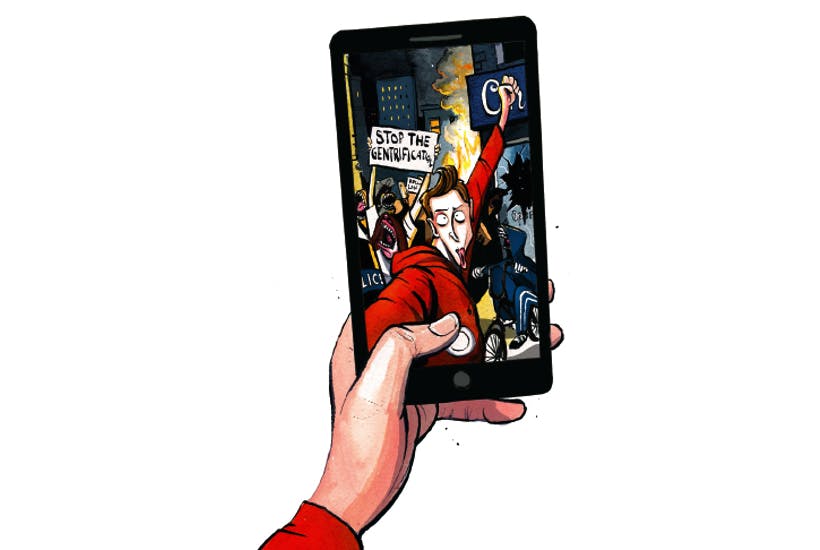What causes riots? How do peaceful, civilised protests turn into violence and anarchy? It can take just a few factors. First, the unfortunate death of a criminal who has come into contact with police. Second, poor public relations from the police or IPCC, who are too often sluggish to explain what has occurred and why – especially in those communities with a history of distrust. Last, the involvement of a hard core of individuals with criminal intent, who become parasites on legitimate protest, twisting it into something much nastier.
If that makes the process sound like slow evolution, consider the pace at which the 2011 riots took hold. It all began on 4 August, a Thursday, when armed police shot dead Mark Duggan – reported by the media as a ‘violent gangster’ and later found to have been in possession of an illegal handgun. By Saturday, a 300-strong protest was marching on Tottenham police station, where no sufficiently senior officer was available to address the crowd. A police car was soon set alight, and from there it spread like wildfire. Within days homes and businesses across London would be looted and destroyed.
In other words, things kick off very quickly. Full-scale riots are infrequent, but right now we’re only ever one step away from a perfect storm that leads to serious civil disorder and crime of the kind seen six years ago. There’s a combustible environment: all that’s lacking is the match.
This week’s Spectator cover story – on riot chic – is confirmed from my own experience policing London. Individuals from comfortable middle- and upper-class backgrounds who rush to involve themselves in protests are a breed of useful idiot to the real criminals.
They think it’s a virtue-signalling contest – supplementing outrage with violence. If they see their cause as righteous, then violent disorder becomes acceptable and desirable. They think nothing of shrieking their favourite chant, ‘No justice, no peace; fuck the police’, as if this somehow helps make Britain safer for the poorest and most vulnerable in society.
But inevitably, it’s the poorest and most vulnerable who suffer when things get out of hand: the minimum wage employees of the looted off-licence and their elderly customers, the hard-working young family burned out of their small flat, not the well-off twenty-something who hops in an Uber to get home at the end of the night.
Too many of these posh protesters don’t realise just how quickly legitimate protest can mutate into violent disorder and criminality – and the harm such violence does to what might be legitimate causes.
Institutional complacency from the police doesn’t help in these explosive situations. Officers used to facilitating peaceful protests and rallies, on whatever is the topic du jour, can sometimes find themselves at a loss when it goes pear-shaped. While other countries are trained and equipped with a wider range of options to quell the violence before it really gets going, Britain clings to an archaic model of boots, shields and, bizarrely, cavalry charges.
Modern CS-infused paintball-style pellets aimed at the ground in front of a group can thin the crowd, leaving only the most determined and unruly behind. But, as in 2011, we continue to prefer exhausting an ever-thinner blue line, having them run backwards and forwards for hours on end to little positive effect, serving as dehydrated punch-bags with shields for umbrellas as bottles and worse rain down.
But the real gamechanger that today’s police and IPCC have to contend with – and why their public relations really must improve so dramatically – is the smartphone-wielding ‘citizen journalist’. They can fulfil a public good, videoing criminals for prosecution or capturing genuinely poor police practice. At other times they spread footage, on WhatsApp and Snapchat, of reasonable police action, but, utterly devoid of context and in a PR vacuum, it goes viral triggering ill-informed troublemakers and privileged agitators who happily spread the ‘fake news’ hoping for a riot.
My advice to those seeking out ‘riot chic’ – especially the social justice warriors of modern Britain – is straightforward. If they were serious about protecting the weak and vulnerable, and tackling injustice, they wouldn’t throw bricks and bottles at police – they’d join their ranks, either as volunteer Special Constables or full-time officers. Failing that, they’d volunteer for a local charity or community group that helps real people – one of the Centre for Social Justice’s Alliance of 350 poverty-fighting charities would be a good place to start.
If they instead join the anarchists and supposed anti-fascists in rioting, they only risk harming the poorest, harming any legitimate cause they claim to be helping and spending time at Her Majesty’s pleasure having earned a criminal conviction.
Rory Geoghegan is Head of Criminal Justice at the Centre for Social Justice. He was previously a Metropolitan Police officer for five years






Comments